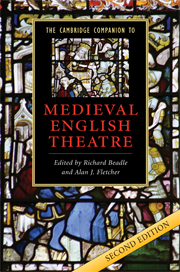Book contents
- Frontmatter
- 1 An introduction to medieval English theatre
- 2 The theatricality of medieval English plays
- 3 The cultural work of early drama
- 4 The York Corpus Christi Play
- 5 The Chester cycle
- 6 The Towneley pageants
- 7 The N-Town plays
- 8 The non-cycle plays and the East Anglian tradition
- 9 Morality plays
- 10 Saints and miracles
- 11 Modern productions of medieval English drama
- 12 A guide to criticism of medieval English theatre
- Select bibliography
- Author index to the bibliography
- General index
8 - The non-cycle plays and the East Anglian tradition
Published online by Cambridge University Press: 28 November 2011
- Frontmatter
- 1 An introduction to medieval English theatre
- 2 The theatricality of medieval English plays
- 3 The cultural work of early drama
- 4 The York Corpus Christi Play
- 5 The Chester cycle
- 6 The Towneley pageants
- 7 The N-Town plays
- 8 The non-cycle plays and the East Anglian tradition
- 9 Morality plays
- 10 Saints and miracles
- 11 Modern productions of medieval English drama
- 12 A guide to criticism of medieval English theatre
- Select bibliography
- Author index to the bibliography
- General index
Summary
The predominance of East Anglia over all other regional theatrical traditions in late medieval England, as evidenced by the sheer number of recorded performances and by the variety of associated play texts, has been apparent since the time of Chambers. This fact, however, has ordinarily been obscured by the critical and historical attention (not undeserved) lavished upon the great civic cycle plays that flourished elsewhere in the country. Chambers, drawing together ‘Representations of mediaeval plays’ in Appendix W to his monumental The Mediaeval Stage (33, vol. 11, pp. 329–406), listed all known towns and villages sponsoring or partaking in some kind of dramatic performance. Forty-eight of his total of 127 locations, spread over thirtyfour counties of England, Ireland and Scotland – that is, nearly forty per cent – were located in the four counties, or parts of counties, that comprised East Anglia. More recent scholarship has of course identified many other such theatrically inclined towns and villages since Chambers compiled his data over a century ago, and the total for East Anglia, now easily double or triple the number he turned up, simply reaffirms its primary position (307). Chambers himself puzzled over his figures, noting that although ‘a vigorous and widespread dramatic activity throughout the length and breadth of the land … naturally finds its fullest scope in the annually repeated performances of several amongst the greater cities, yet it is curious to observe in what insignificant villages it was from time to time found possible to organize plays’ (33, vol. 11, p. 109).
- Type
- Chapter
- Information
- The Cambridge Companion to Medieval English Theatre , pp. 211 - 234Publisher: Cambridge University PressPrint publication year: 2008
- 5
- Cited by



